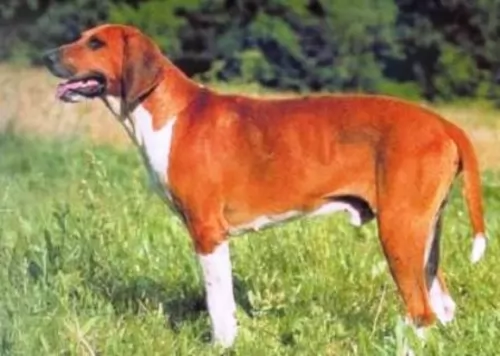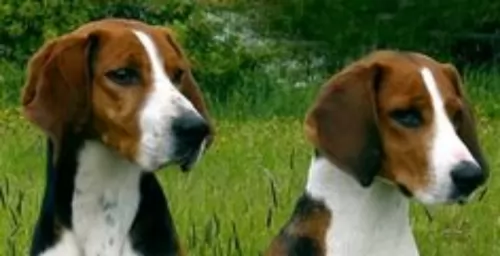 Petzlover
PetzloverFrancais Blanc et Orange is originated from France but Pugnaces Britanniae is originated from United Kingdom. Both Francais Blanc et Orange and Pugnaces Britanniae are having almost same height. Francais Blanc et Orange may weigh 74 kg / 163 pounds lesser than Pugnaces Britanniae. Francais Blanc et Orange may live 7 years less than Pugnaces Britanniae. Francais Blanc et Orange may have less litter size than Pugnaces Britanniae. Both Francais Blanc et Orange and Pugnaces Britanniae requires Low Maintenance.
 The Chien Francais Blanc et Orange is one of the three versions of the Chien Francais. There is the Francais Blanc et Noir and the Francais Tricolor. These scent hounds were distinguished by their colors. The Francais Blanc et Orange like the other two, was a descendent of a variety of English and French hunting hounds, including the Hound of Saintonge.
The Chien Francais Blanc et Orange is one of the three versions of the Chien Francais. There is the Francais Blanc et Noir and the Francais Tricolor. These scent hounds were distinguished by their colors. The Francais Blanc et Orange like the other two, was a descendent of a variety of English and French hunting hounds, including the Hound of Saintonge.
The Hound od Saintonge is extinct but has several breeds coming from his line including the Billy – a pointer. Similar to the Francais Blanc et Orange, the Billy hunted in packs. Coming from these roots the Francais Blanc et Orange was developed around the 1900’s. Many considers the Chien Francais trio to be the Newest and Rarest French Hounds. The Francais Blanc et Orange is a white and orange hound, considered to be the rarest of the three. They were developed by crossing English Foxhounds with French Scent Hounds.
The Francais Blanc et Orange is a born hunter and a good one at that. In his pack he is happy and superbly equipped for the hunt. His vision and scenting skills are unsurpassed. They can cover a large expanse of territory in a very short period of time. They were known for hunting large boar and deer as well as small prey like foxes or rabbits. They were recognized as a separate breed by the UKC in 2006 but are not recognized by the AKC.
Pugnaces Britanniae is a dog which is now extinct. There isn't certainty surrounding the origins of the dog but it is thought they descended from dogs brought to Britain way back in the 6th century BC already.
These are ancient dogs, and when you do research you find references dating back to centuries ago. In fact when you read of the Roman conquest of Britain you read of huge dogs, which the Romans referred to as Pugnaces Britanniae.
It is believed that the English Mastiff descended from the ancient Alaunt and Pugnaces Britanniae and that the dog was used as a war dog.
 The Francais Blanc et Orange is a large , muscular and lean hunting dog, a typical pack hound out of France. They have a flat to somewhat domed head, long legs, and dropped, long ears and a square muzzle. The nose is either orange-brown or black and has large nostrils. Their eyes are deep set, dark and widely spaced. They have a deep chest which leads to their propensity toward the situation of bloat. This breed is smaller than the Chien Francais Blanc et Noir that hunts in packs. The skin is the fur’s color. They are athletic and display tremendous perseverance.
The Francais Blanc et Orange is a large , muscular and lean hunting dog, a typical pack hound out of France. They have a flat to somewhat domed head, long legs, and dropped, long ears and a square muzzle. The nose is either orange-brown or black and has large nostrils. Their eyes are deep set, dark and widely spaced. They have a deep chest which leads to their propensity toward the situation of bloat. This breed is smaller than the Chien Francais Blanc et Noir that hunts in packs. The skin is the fur’s color. They are athletic and display tremendous perseverance.
The Pugnaces Britanniae was a huge dog standing at roughly 67 to 75cm and weighing 52 to 110kg.
He was a heavily built dog, a Mastiff type dog that had a large head, broad muzzle with fairly loose skin around the mouth, brown eyes, a broad back and rump, muscular legs and floppy ears with a long tail. In fact the Mastiff, thought to have descended from the ancient Alaunt and Pugnaces Britanniae, gives you an idea of what the dog looked like. He no doubt has a short, smooth coat available in fawn, tan or brindle and with the black mask.
The Pugnaces Britannia was a naturally aggressive dog so it is to be expected that he wouldn’t automatically have been a good family dog, possibly being aggressive around children and other dogs. They were intelligent and were no doubt taught some simple commands.
They were also very territorial dogs, wanting to instinctively chase and attack unknown people and animals. They were strong minded, confident, loyal ad loving dogs towards their owners, being protective of them, wanting to please them.
 They are not exactly child oriented dogs as they are so oriented toward the hunt and the pack. With serious exercise and mental stimulation, they can become a good family dog, but it is not in their instincts.
They are not exactly child oriented dogs as they are so oriented toward the hunt and the pack. With serious exercise and mental stimulation, they can become a good family dog, but it is not in their instincts.
hunting in packs/scent and vision
He is not suited for apartment life and does need a large, fenced yard to run and play. Being a scent hound, he will constantly be sniffing for a trail to follow so put him to work.
The breed is highly intelligent and easily trainable.
The Pugnaces Britanniae may well have been a large dog and quite imposing to look at but he was in all likelihood a good-natured pet who got on well with his family members, being loyal and loving if brought up correctly.
Long ago dog training and socialization didn’t exist but a large dog like this would have to be socialized and trained to become obedient and an amicable all-rounder.
 As with any dog with log floppy ears, infection is always a concern. Make sure you clean them after every hunting trip, romp or play session.
As with any dog with log floppy ears, infection is always a concern. Make sure you clean them after every hunting trip, romp or play session.
Like many large dogs the Blanc et Orange has a propensity to acquire hip dysplasia. It is known that joint dysplasia has a genetic component and should be screened for. Can cause lameness and arthritis.
This is a real danger for the Blanc et Orange. They are deed chested and these are the dogs that are most likely to get bloat. The stomach is twisted and distended. It can be fatal if not treated quickly.
The Pugnaces Britanniae could live to 10, 11 or 12 years of age with good care. Large Mastiff type dogs like this would have had to watch out for common canine diseases such as hip dysplasia, cancer and bloat.
In those days, no screening tests were available for health problems like this. Gastric dilatation volvulus or bloat is a common health issue with large, deep chested dogs where the stomach fills with gas and the stomach twists. Its a life threatening disease.
Canine heart disease is another serious health issue with these mastiff type dogs. Early stages with heart disease show there may well be no symptoms at all. However, as the heart disease progresses towards congestive heart failure, the dog will have symptoms such as fatigue, difficulty with breathing, weight loss, a distended abdomen and coughing.
A dog with symptoms like this would have to see a vet immediately.
 Until about 18 months of age feed between 1 and 1.5 cups of high quality puppy, dry food, made for sporting dogs. Divide this into 3 meals per day.
Until about 18 months of age feed between 1 and 1.5 cups of high quality puppy, dry food, made for sporting dogs. Divide this into 3 meals per day.
3 cups day – After 18 month feed 3 cups per day of a high quality, adult dry food made for sporting dogs. Divide this into 2 meals per day.
Outstanding scent and vision
Even though they are warm and welcoming to people, these are very serous dogs. They usually live outside in packs as they are an incredible pack animal. All they want in life is to hunt. However, if they cant hunt they need at least a couple hours per day od vigorous exercise. They are obviously better off in a rural environment than a city one. Put him in field trails, scent trials, barn hunt and playing fetch.
The diets of ancient dogs were different to what they are today, as in those days there were no commercially manufactured dog foods. Dog owners in all likelihood tossed scraps to them which included starch.
Today a large dog such as the extinct Pugnaces Britannia would have no doubt been fed a high quality kibble from a leading brand and packed with minerals and vitamins specially formulated for a large dog breed.
Homemade food is also important, but not any kind of food – it has to be food which doesn’t upset the dog’s digestive system. Simple but nutritious food such as boiled chicken, brown rice or pasta, sweet potatoes, carrots and spinach is ideal for a dog, and when it is chopped up can be added twice a week to the dry kibble for a tasty, healthy treat.
Raw meat added in occasionally is also hugely beneficial. No dog should ever be without fresh, cool water constantly available.
As a short haired dog, the Pugnaces Britanniae would have required a brushing twice a week to rid the dog of loose hairs. Maybe in those days they didn’t check their dogs over to see that all was well, but today you would need to check the inside of the ears. If the insides were red, it could be a sign of an ear infection brought on by dampness, excess wax and dirt.
The eyes would need to be checked for discharge and the teeth checked a well. One rotten tooth can cause a lot of havoc. The nails of the dog would have had to be checked and clipped as well.
As a war dog, the Pugnaces Britanniae would have been fit. He is a big dog and while they require exercise such as walks and hide-and-seek type of games, he isn’t the kind of dog that would go running with you on a jog, as large, heavy dogs can overheat easily.